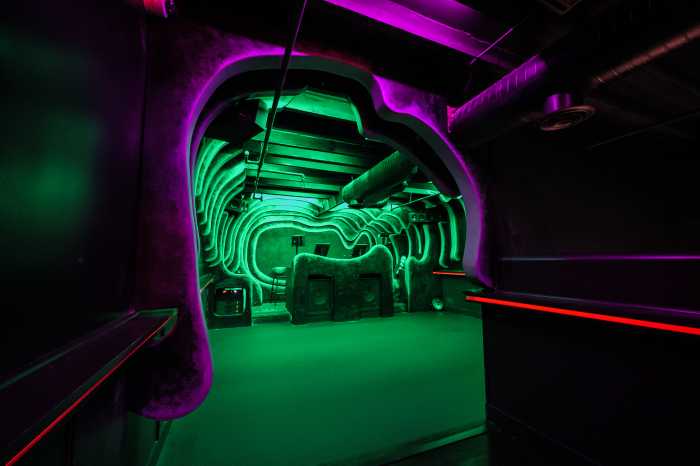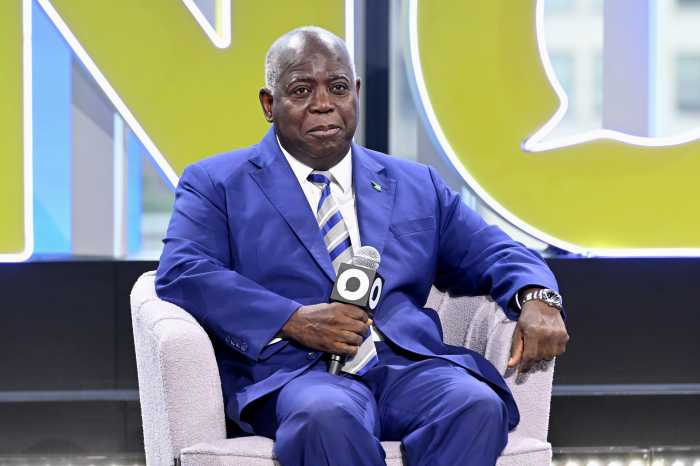After battling to have their voices heard in an official public forum,
community members were left fuming this week when a City Council hearing
on the Atlantic Yards arena proposal left them waiting nearly five hours
to testify.
The delay meant that their testimony was not heard by most daily news
media, whose reporters left to file stories for the evening deadline,
and even many council members and officials had long since departed the
council chambers by the time the largely anti-arena testifiers spoke.
By the last hour of the hearing, which ran until about 7:30 pm, only the
chairman of the Economic Development Committee that hosted the hearing,
Queens Councilman James Sanders, and Prospect Heights Councilwoman Letitia
James, a member of the committee and a staunch opponent of the plan, remained
out of nine members of the panel.
More than 300 supporters and opponents of the plan packed into the standing-room-only
council chambers at 10 am on Tuesday, many taking the day off from work
to weigh in on the $2.5 billion commercial, retail and residential development
in Prospect Heights.
While representatives of Atlantic Yards developer Bruce Ratner and his
Forest City Ratner company, as well as officials from the city Economic
Development Corp. and Borough President Marty Markowitz — both proponents
of the plan, which would bring the New Jersey Nets basketball team to
Brooklyn — all got a chance to speak at some length, community members
were offered just two-minute slots and did not get to testify until after
3 pm.
By that time less than half of those who had wished to testify remained
and only a handful of council members were still in attendance.
Almost all the press had gone, and even the EDC officials had packed up
their bags and headed out.
Bertha Lewis, executive director of the Association of Community Organizations
for Reform Now (ACORN), which is in support of the plan, blasted officials,
saying that if city officials had really wanted community input they would
have let the community speak.
ACORN brought six buses of supporters of Ratner’s arena, office skyscraper
and housing plan to the hearing.
“Some community members had to leave to go pick up their children
from school,” said Lewis, who railed against the hearing’s organizers
for putting off community speakers until the end.
Norman Siegel, the lawyer and former head of the New York Civil Liberties
Union, who is representing about 150 residents fighting the condemnation
of their property to build the 21-acre development, also called the hearing
“extremely unfair.”
“People this morning said they wanted an open process — this
shows that at best it’s rhetoric. They would be here,” said
Siegel, referring to Ratner and city officials.
Ratner purchased the New Jersey Nets in January and plans to bring them
to Brooklyn. In addition to an 800,000-square-foot arena, he seeks to
build four soaring office towers and 13 residential buildings.
While the original plan included knocking down more than two square blocks
of privately owned property, Forest City Ratner officials
said at Tuesday’s hearings that they are working to minimize the
eminent domain taking of property.
“We’re looking at substantially modifying our plan if necessary,”
said FCR Vice President James Stucky. “We’re working with many
of the residents and we’re doing whatever we can to try and reduce
the amount of condemnation because we think there’s a win here, that
we can do this project … and do it in a way where we don’t have
to condemn people’s homes.”
But Stuckey said it was “a little premature” to discuss specifics,
adding that they were looking at both shifting the plan and offering buyouts
to residents to reduce the amount of eminent domain.
The Brooklyn Papers reported on April 24 that Ratner and the architect
for Atlantic Yards, Frank Gehry, were working on plans to construct a
new building to house some of the residents his plan would displace. And
Gehry told Newsweek online last month, “Bruce [Ratner] is asking
me to design a new apartment building for them [neighbors whose apartments
might be destroyed by the complex].
He’s got a specific site nearby.”
Pressed by Manhattan Councilwoman Christine Quinn at the hearing about
how much public money would be needed to build Atlantic Yards, Stuckey
was evasive, first saying only that it was less than $1 billion and more
than $10 million. Pushed further by Quinn, who asked if the price tag
would be in “the hundreds of millions,” Stuckey said, “I
think that’s fair.”
That cost would put it on a par with the planned stadium for the New York
Jets football team on Manhattan’s Upper West Side. That project,
which would also be a major part of the city’s bid for the 2012 summer
Olympics, would cost the city and state $300 million each.
Ratner has from the beginning pitched his arena, office and housing plan
as being primarily funded by the tax dollars it would generate, much of
which would come from the personal income taxes paid by the Nets basketball
players.
Neither he nor city or borough officials have been willing to divulge
the actual projected cost to the city.
An economic study on the arena commissioned by Ratner and released this
week, estimated a public contribution of $18 million in city and state
funds in addition to $187.5 million in infrastructure costs.
Andrew Alper, president of the EDC, a city-run non-profit intended to
spur business and industrial growth, praised the project at the hearing,
saying the “benefits far outweigh the costs.”
Alper said the Atlantic Yards plan would create 14,400 construction jobs
and 7,600 permanent jobs.
Developers have also agreed to set aside 50 percent of the 4,500 units
of housing for middle- and low-income housing.
Asked by several council members how much money the city expected to plunk
down, Alper said they were still working the figures.
“Until we know what kind of public financing [is involved] I don’t
think we can say the benefits far outweigh the costs,” said Downtown
Brooklyn Councilman David Yassky.
Alper said EDC would have those figures in the next few weeks.
The plan will most likely face a state review process and bypass the much
more stringent city land use review process.
James, who helped push for the Council hearings, said she was disappointed.
“We didn’t get any commitments on City Council playing a role,
eliminating eminent domain, or real affordable housing,” said James.
Before the hearing, James hosted a press conference to discuss alternative
design plans for the Long Island Rail Road yards over which about half
of the Ratner plan would sit.
Those designs included shifting the arena over Atlantic Avenue on a raised
platform and onto the Atlantic Center mall site that Ratner owns across
the street.
Architect and urban designer Marshall Brown also presented plans for a
site along the rail yards that includes buildings five to 10 stories tall
with interlacing streets “stitching together” Fort Greene and
Prospect Heights.
Neither plan would require the use of eminent domain as the project would
be shifted a block north.
Rep. Major Owens proposes moving the entire plan to the Brooklyn Navy
Yards.
























